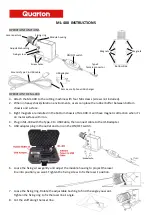
Appendix E: Equivalent-Time (ET) oscilloscope operation
4.
Now only the top slider will make any difference. Click
Run
to get a
repeating constellation and eye-diagram update. Click the + and – to make
0.1-ps adjustments to the top slider until the BPSK constellation shows as
perfectly straight lines connecting the two groups of constellation points as
shown above. (See Figure 18.)
5.
Displaying the X-Q eye will show the BPSK signal going into the “wrong”
quadrature. When the delay is set properly the X-Q signal shown should
only be noise.
6.
Shut down the RX X-polarization by again moving the polarization state
of the signal and disabling channels the RX X-polarization channels. Now
only the bottom slider will matter.
7.
Move the last slider using the + and – buttons to get 0.1-ps changes until the
constellation looks as it did with the RX X-polarization channels. Once again
use the X-Q eye as a measure of residual error as well as constellation quality.
Note that the data is displayed in the X-I diagram because X and Y on the
OUI plots refer to transmitter polarization signals, not receiver outputs. When
only one transmitter polarization signal is present it is called “X.”
OM4000D Series Coherent Lightwave Signal Analyzer
133
Summary of Contents for OM4006D
Page 2: ......
Page 6: ......
Page 22: ...Compliance information xvi OM4000D Series Coherent Lightwave Signal Analyzer...
Page 24: ...Preface xviii OM4000D Series Coherent Lightwave Signal Analyzer...
Page 100: ...Taking measurements 76 OM4000D Series Coherent Lightwave Signal Analyzer...
Page 146: ...Appendix D Automatic receiver deskew 122 OM4000D Series Coherent Lightwave Signal Analyzer...
Page 202: ...Appendix H Cleaning and maintenance 178 OM4000D Series Coherent Lightwave Signal Analyzer...
Page 205: ...Index W Waveform averaging 48 OM4000D Series Coherent Lightwave Signal Analyzer 181...
















































